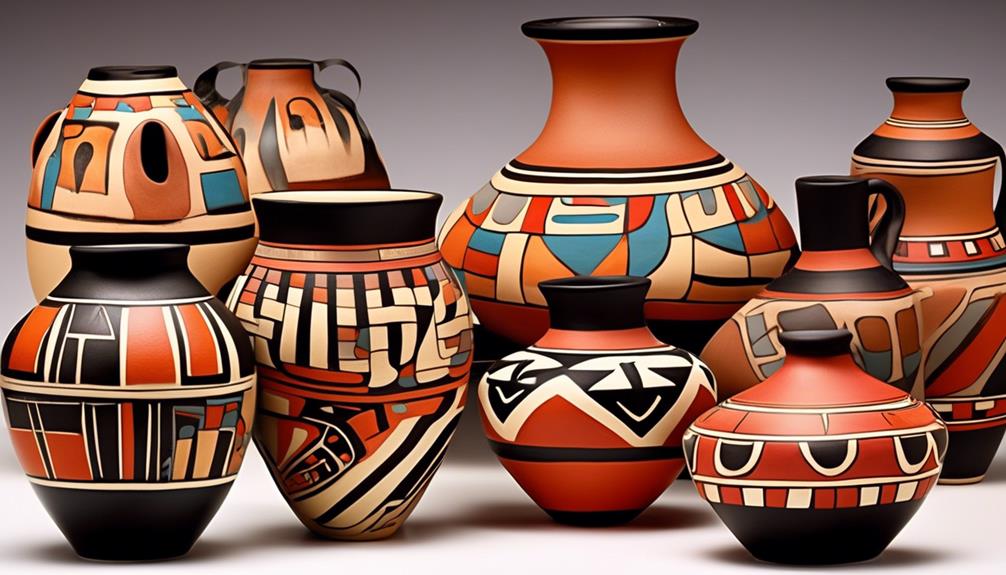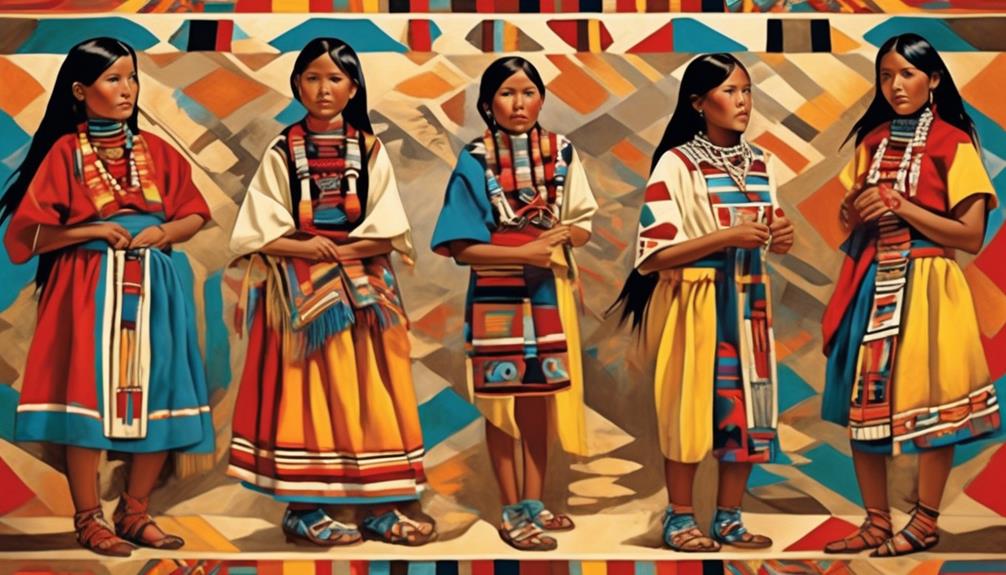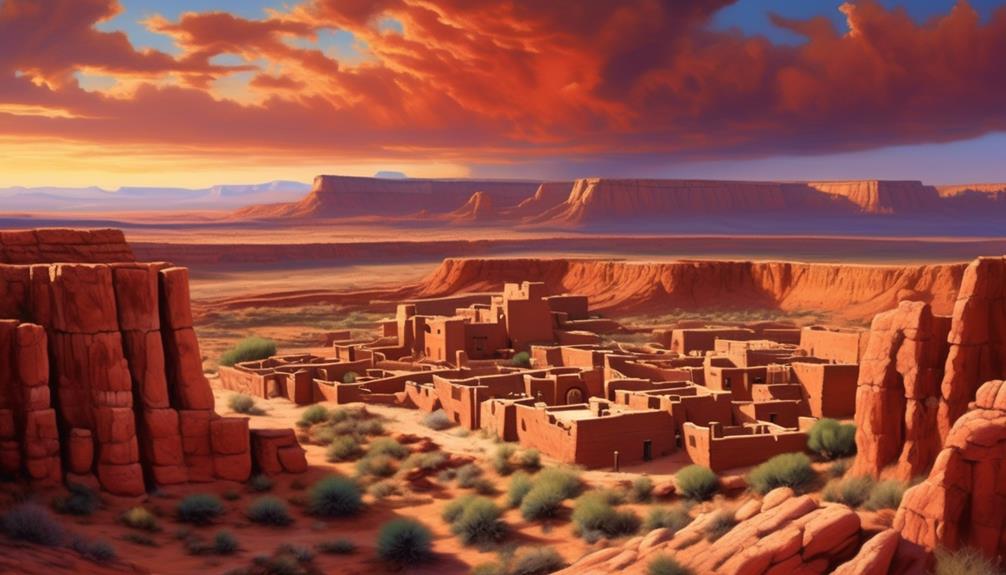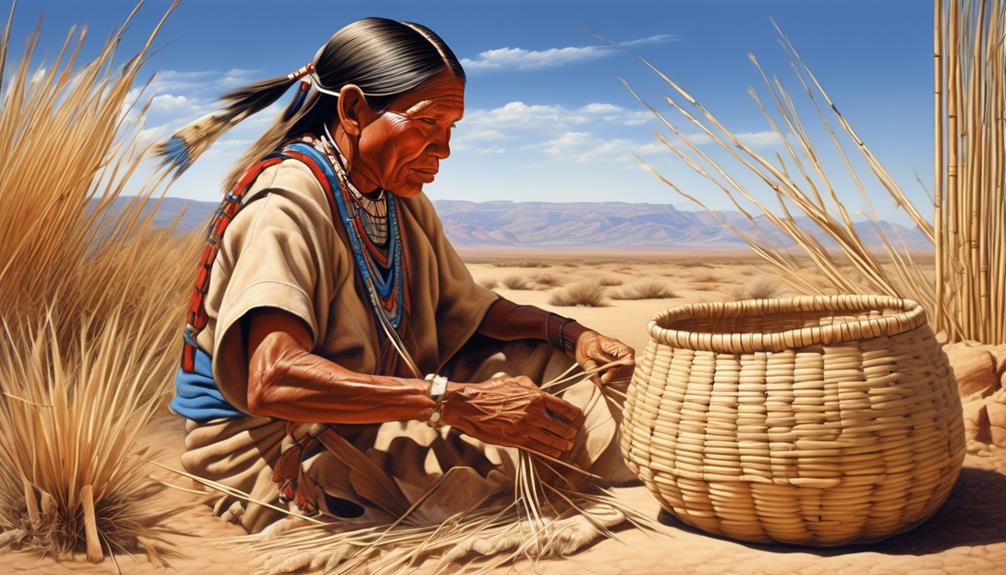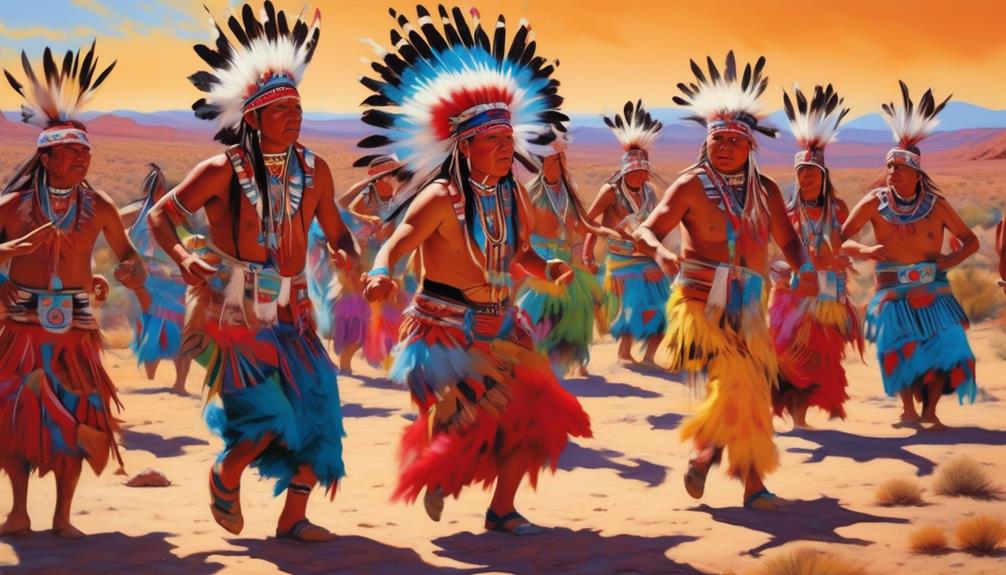Exploring the art of the Hopi tribe is similar to stumbling upon a secret stash just waiting to be uncovered. The deep cultural roots of the Hopi community shine through in the various masterpieces they have crafted through the ages. Delve into this captivating world and unearth the beauty of their traditions and creativity. Start your journey now to uncover the hidden gems of the Hopi tribe.
From intricately designed pottery and vibrant kachina dolls to stunning textiles and exquisite jewelry, the art of the Hopi tribe is a window into their beliefs, traditions, and way of life.
But there's more to this artistic legacy than meets the eye, and understanding the significance behind each creation unveils a deeper connection to the Hopi culture.
Key Takeaways
- Hopi Pottery: Plays a central role in the Hopi Tribe's artistic and cultural heritage, reflecting their deep connection to the land and spiritual beliefs. Techniques are passed down through generations, involving gathering clay, hand-coiling pottery, and using natural pigments. The designs on the pottery symbolize the natural world, ancestral stories, and religious beliefs.
- Kachina Dolls: Hold a revered place in Hopi Tribe's artistic and cultural traditions. These wooden figures represent spirits from the Hopi religious pantheon and are intricately carved and adorned with feathers and paint. The symbolism in Kachina dolls reflects the characteristics and powers of the corresponding Kachina spirit. They are used in traditional kachina dances to honor spirits and teach cultural heritage.
- Textiles: Crafted with intricate artistry and spiritual significance, Hopi textiles reflect a profound connection to the tribe's heritage and belief system. Weaving techniques are passed down through generations, and patterns incorporate symbolic elements representing animals, plants, and celestial bodies. They serve as a means of storytelling and preserving cultural narratives and beliefs.
- Jewelry: Hopi jewelry reflects the deep cultural traditions and spiritual connections of the Hopi people. Turquoise jewelry symbolizes water, sky, and the union of earth and sky. Silverwork techniques are used to illustrate stories and represent spiritual beliefs. The intricate designs and symbols on the jewelry reflect ancestral traditions and reverence for the natural world. Each piece carries a profound sense of identity and heritage.
- Murals: Encapsulating a deep reverence for the natural world and ancestral heritage, Hopi murals carefully choose symbolism to convey cultural and spiritual meanings. They depict scenes from Hopi mythology and oral traditions, using vibrant colors and intricate patterns that reflect the connection to the natural world. Murals serve as visual representations of the Hopi way of life and cultural identity.
Pottery
Pottery plays a central role in the artistic and cultural heritage of the Hopi Tribe, reflecting their deep connection to the land and their spiritual beliefs. Hopi pottery techniques are deeply rooted in tradition and are passed down through generations. The process involves gathering clay from specific locations, hand-coiling the pottery, and using natural pigments to create intricate designs. The craftsmanship and skill involved in creating Hopi pottery are a testament to the tribe's dedication to preserving their cultural practices.
Symbolism in Hopi pottery designs is rich and significant. Each symbol and motif holds deep spiritual meaning, often representing elements of the natural world, ancestral stories, and religious beliefs. The use of geometric patterns and symbolic imagery serves as a form of storytelling, allowing the pottery to convey narratives that have been cherished by the Hopi people for centuries.
The intricate designs not only showcase the artistic prowess of the potters but also serve as a means of cultural preservation, ensuring that the stories and beliefs of the Hopi Tribe continue to be shared and celebrated through their art.
Kachina Dolls
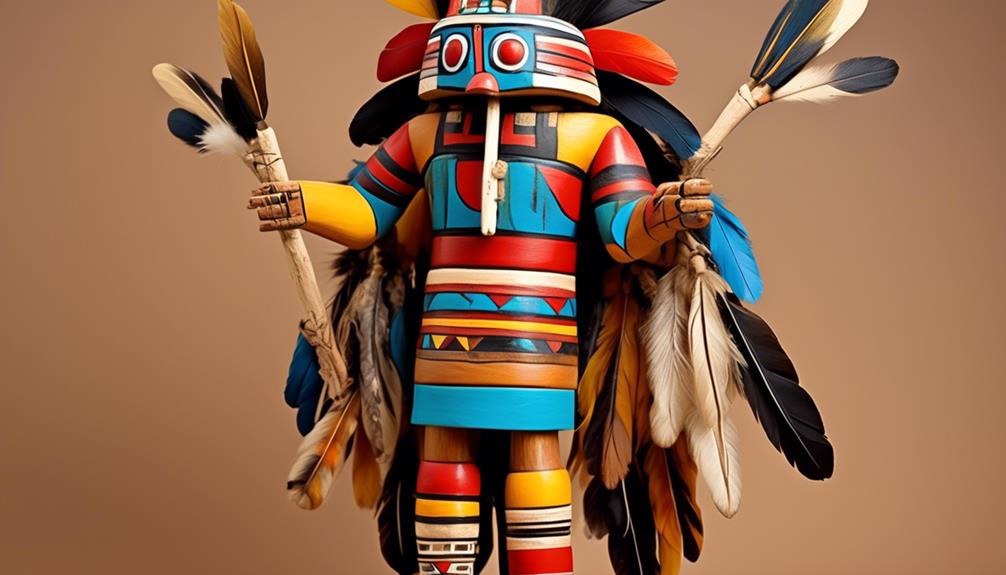
With intricate craftsmanship and symbolic significance, Kachina dolls hold a revered place in the artistic and cultural traditions of the Hopi Tribe. These wooden figures, often intricately carved and adorned with feathers and paint, represent spirits from the Hopi religious pantheon, known as Kachinas. Each Kachina doll holds deep symbolism, with specific attributes and designs reflecting the characteristics and powers of the corresponding Kachina spirit. Through these dolls, the Hopi people pass down their spiritual beliefs and cultural traditions to future generations.
Kachina doll symbolism is integral to the traditional kachina dances, where masked dancers embody the spirits depicted in the dolls. These ceremonial dances are a vital part of Hopi religious and social life, serving as a way to honor the spirits, request their blessings for the community, and teach younger tribal members about the religious and cultural heritage. The Kachina dolls play a central role in these rituals, serving as visual aids that help community members recognize and connect with the spirits being portrayed.
The intricate artistry and spiritual significance of Kachina dolls make them a cornerstone of Hopi artistic and cultural expression, representing a profound connection to the tribe's heritage and belief system.
Textiles
The intricate artistry and spiritual significance of Kachina dolls are paralleled in the exquisite textiles crafted by the Hopi Tribe, reflecting a profound connection to the tribe's heritage and belief system. The Hopi people have a long tradition of weaving, creating textiles that aren't only visually stunning but also deeply symbolic. The weaving techniques used by the Hopi Tribe are passed down through generations, with each pattern and motif holding special meaning within the cultural and spiritual context of the tribe.
Traditional patterns in Hopi textiles often incorporate symbolic elements, such as representations of animals, plants, and celestial bodies. These patterns aren't only decorative but also serve as a means of storytelling, conveying important cultural narratives and beliefs. The meticulous weaving techniques, including the use of natural dyes and intricate designs, demonstrate the skill and dedication of the Hopi weavers in preserving their artistic heritage.
Through their textiles, the Hopi Tribe continues to uphold their rich cultural traditions, infusing every thread with the spiritual essence of their ancestors. These remarkable creations serve as a tangible expression of the Hopi people's profound connection to their history and belief system.
Jewelry
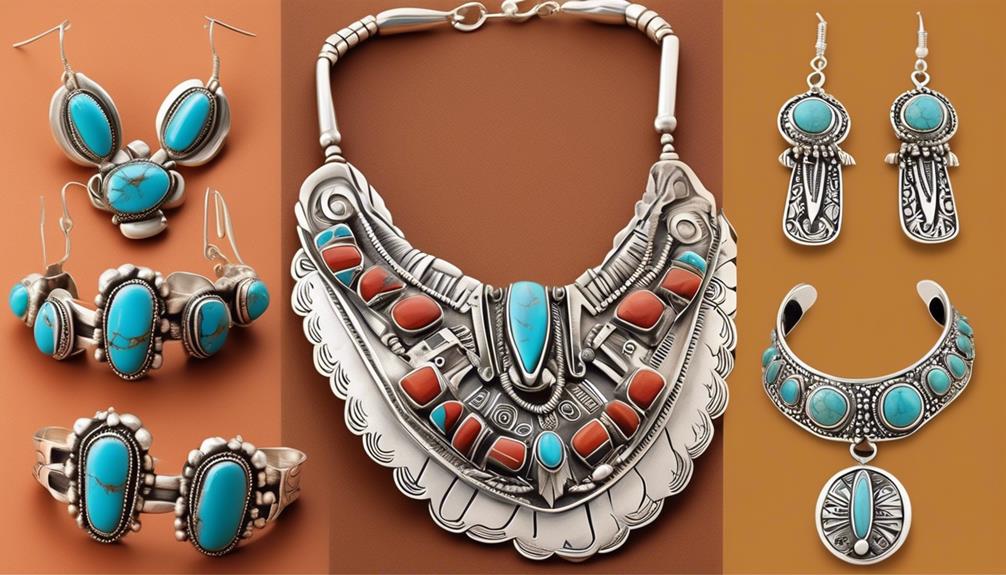
Adorning themselves with an array of meticulously crafted adornments, the Hopi people's jewelry reflects their deep cultural traditions and spiritual connections.
Turquoise jewelry holds immense cultural significance for the Hopi tribe, symbolizing water, sky, and the union of the earth and the sky. The vibrant blue hues of turquoise are believed to bring protection, healing, and good fortune to the wearer, making it a highly revered material in Hopi jewelry.
Silverwork techniques are intricately woven into the jewelry making process, with each piece illustrating a story or representing spiritual beliefs. The use of intricate designs and symbols in silverwork reflects the Hopi people's deep connection to their ancestral traditions and their reverence for the natural world.
Each piece of jewelry isn't just an accessory, but a tangible representation of the tribe's history, beliefs, and values. The art of creating jewelry is a deeply spiritual and cultural practice for the Hopi people, and each piece carries with it a profound sense of identity and heritage.
Murals
Reflecting the vibrant cultural traditions and spiritual connections of the Hopi people, the murals created by the tribe encapsulate their deep reverence for the natural world and ancestral heritage. The symbolism in murals is a central aspect of Hopi art, with each element carefully chosen to convey specific cultural and spiritual meanings. These murals often depict scenes from Hopi mythology, such as the katsina spirits and the emergence of the Hopi people, serving as visual narratives that pass down their oral traditions. The use of vibrant colors and intricate patterns in the murals reflects the tribe's connection to the natural world, with each hue and motif holding cultural significance.
Cultural significance is deeply embedded in Hopi murals, as they're often found in significant communal spaces, such as kivas and village walls. These murals aren't merely decorative; they serve as a visual representation of the Hopi way of life, reinforcing their cultural identity and spiritual beliefs. Through these murals, the Hopi people continue to preserve and celebrate their heritage, ensuring that their traditions are passed down through the generations.
Frequently Asked Questions
What Is the Significance of Specific Symbols and Designs Used in Hopi Pottery?
The specific symbols and designs used in Hopi pottery hold deep cultural significance. They carry symbolic meanings that are often tied to religious ceremonies and traditional techniques.
The pottery designs reflect the artistic excellence and spiritual beliefs of the Hopi tribe. These designs are also reflected in textile creation, further emphasizing their importance in preserving and passing down traditional knowledge and cultural heritage.
How Are Kachina Dolls Used in Hopi Religious Ceremonies?
Kachina dolls play a crucial role in Hopi ceremonial practices. These intricately crafted dolls represent spirits and deities and are used in religious ceremonies to communicate with the spirit world. They're meticulously carved and painted, each detail holding symbolic significance.
During ceremonies, the dolls are danced and gifted to bring blessings upon the community. The role of kachina dolls reflects the deep spiritual and cultural significance within Hopi traditions.
What Techniques Are Used to Create Traditional Hopi Textiles?
Traditional weaving techniques are integral to Hopi textiles, showcasing intricate patterns and vibrant colors. The use of natural dyeing processes imparts cultural significance, with each color representing elements of Hopi cosmology and mythology.
The art of weaving is passed down through generations, embodying the tribe's rich cultural heritage. These textiles serve as a visual storytelling medium, embodying the Hopi people's deep connection to their traditions and beliefs.
What Materials Are Commonly Used in Hopi Jewelry Making?
We discovered that silverwork techniques and turquoise jewelry are commonly used in Hopi jewelry making. Alongside this, beadwork patterns and lapidary art are also prevalent.
Hopi jewelry often showcases intricate designs and vibrant colors, reflecting the tribe's rich cultural heritage. The use of these materials and techniques highlights the artistic skill and craftsmanship of the Hopi tribe, making their jewelry a significant part of their cultural identity.
What Themes and Stories Are Typically Depicted in Hopi Murals?
Hopi mural themes often revolve around traditional storytelling and symbolism, depicting their deep connection to the land and their spiritual beliefs. These murals showcase the significance of kachina doll ceremonies and portray the intricate textile creation techniques.
The artwork also reflects the symbolism found in Hopi pottery and the stories passed down through generations. The vibrant colors and intricate designs in the murals capture the essence of Hopi culture and history.
Conclusion
In conclusion, the Hopi tribe's art is a vibrant and integral part of their culture, reflecting their deep connection to nature and spirituality.
The intricate pottery, colorful kachina dolls, beautiful textiles, and stunning jewelry all showcase the tribe's creativity and skill.
The murals, with their rich symbolism and storytelling, are a testament to the Hopi's cultural richness and artistic legacy.
It's truly awe-inspiring to witness the depth and beauty of their artistry.
